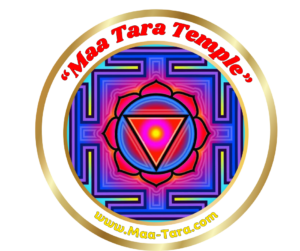Temple for the worship Of
Maa Tara



In Her Wrathful and Fierce Form, Maa Tara Is Revered As Maa Ugra Tara. In both Buddhist and ancient Indian traditions, Maa Ugra Tara Is Also Venerated As Maa Mahacina Tara.
In the tantric text mantra-mahodadhih, written in Varanasi in the year 1589 by mahidhara, the Dhyana mantra for the worship Of Maa Ugra Tara describes The Depiction Of Maa Ugra Tara, Visualizing Her Sitting On A White Lotus Amidst The Waters That Engulf the universe During The Great Dissolution (Maha Pralaya).
The dhyana mantra for the worship Of Maa Ugra Tara is as follows:
“Viśvavyāpaka Vārimadhyavilāsacchvetāmbujanastitām |
Kartrīkhadgakapālalīnanalinai Rajatakarām Nīlābhām /
Kāñcīkundalahārakaṅkanalasatkeyūramañjīrāṭām
Aāptair Nāgavarair Vibhūṣitatanūm Araktanetra Trayām // 4.39
Piṅgostaraikajaṭām Lasatsurasanāṃ Daṃṣṭrākarālanānāṃ
Carma Dvaipi Varaṃ Kaṭau Vidadhatīṃ Svetāśhipatālīkām /
Akṣobhyena Virājāmānasīrasāṃ Smerānānāmbhoruhām
Tārām Iśvarībhadrāsanāṃ Dṛḍhakucāṃ Ambāṃ Trilokyāḥ Smaret // 4.40”
“I meditate Upon The Divine Mother Of the three worlds, Who Is Sitting On A White Lotus Situated In The Centre Of The Waters Enveloping the entire universe. Maa Ugra Tara Is Depicted Holding In Her Left Hands, A Knife And a skull, And In Her Right Hands, A Sword And A Blue Lotus. With Three Eyes And Matted Hair, Maa Ugra Tara’s Complexion Is Depicted As Blue, And She Is Adorned With Ornaments And With Three Beautiful Serpents. Maa Ugra Tara Is Also Depicted With A Protruding Tongue, And Her Teeth And Mouth Appear Formidable. Maa Ugra Tara Is Clad In The Skin Of a tiger Around Her Waist, And Her Forehead Is Decorated With Ornaments Of white bone. Sage aksobhya, in the form of a serpent, is situated On Maa Ugra Tara’s Divine Head. Maa Ugra Tara Is Seated On a corpse. Thus one should meditate On Maa Bhagavah Tara, The Divine Mistress Of all three worlds.”
The Depiction Of Maa Ugra Tara Has Similarities With The Depiction Of Maa Maha Kaali, Especially With The Depiction Of Maa Maha Kaali As Maa Dakshina Kaali. Both The Divine Forms Of The Divine Mother Are Depicted Standing On a supine male figure, often recognizable as lord shiva or an unidentifiable corpse. Maa Dakshina Kaali And Maa Ugra Tara Are Depicted With Dark Blue Or Black Complexion, Adorned With severed heads or skulls And A Girdle Of severed arms. Presiding Over cremation grounds, The Divine Forms Are Depicted With Protruding Tongues And Mouth Covered In blood.
In buddhist and ancient indian traditions, Maa Ugra Tara Is worshipped with the mantra “Om Hrim Strim, Hum Phat”. Maa Ugra Tara Is Revered As The Embodiment Of The Most Powerful Vibration Emerging From The Primordial Stillness, Which Is The Source Of all creation. According to the tantrics, Maa Ugra Tara Collects all the ignorance of the three worlds In Her Bowl Made From a skull And Destroys it Instantly.
The Blessings Of Maa Ugra Tara Guide Her deserving devotees to overcome all dangers and miseries. Through sincere worship and meditation On Maa Ugra Tara, By The Blessings Of The Divine Mother, devotees attain knowledge About The Profound Power And Protection Which Guides them to overcome ignorance and achieve spiritual growth.
References
https://en.wikipedia.org/wiki/Maa_Ugra_Tara
https://www.scribd.com/doc/272835049/Ugra-Tara-or-MahaChina-Tara
https://manblunder.com/articlesview/sri-ugra-tara-dvatrimsatyaksara-maha-mantra-japa
https://japanesemythology.wordpress.com/notes-the-ugra-tara-goddess-and-the-cinas/